ASUS P8P67 Review
by Brendan van Varik on September 8, 2011 10:45 AM EST- Posted in
- Asus
- Motherboards
- P67
LAN Speed Test
LAN Speed Test is a freeware program designed for testing the network connection between two PCs on a home network. The speed of the transfer is limited by the lowest common denominator on the network, so if you have gigabit Ethernet capable computers but a 100 Mbit capable router, you are limit to 100 Mbit transfer. Note that this is really a formality – if a network port is rated at 1 Gbps, then chances are that it will hit at least 90+% of this value. The main test here is CPU usage, and how much is offloaded by the controller. For this test, we use LAN Speed Test to transfer a 1000 MB file across a home network with a 100 Mbps lowest common speed to the same machine each time, in a read/write scenario. CPU usage is taken as a visual max/average from task manager. Note: future LAN speed tests will be at the Gbps level.
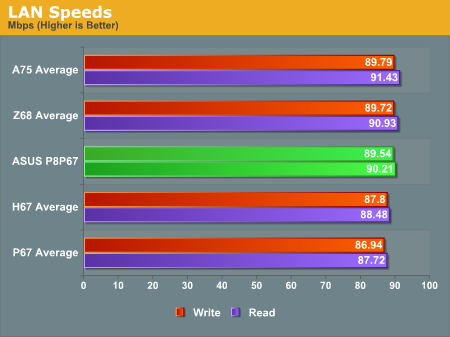
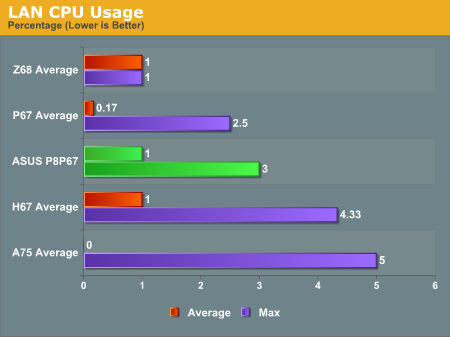
The results on this board are above average so that is a good sign. The CPU usage is low and that means the Realtek controller doing its job so that the transfer does not eat up too much of the systems resources.
DPC Latency
Deferred Procedure Call latency is a way in which Windows handles interrupt servicing. In order to wait for a processor to acknowledge the request, the system will queue all interrupt requests by priority. Critical interrupts will be handled as soon as possible, whereas lesser priority requests, such as audio, will be further down the line. So if the audio device requires data, it will have to wait until the request is processed before the buffer is filled. If the device drivers of higher priority components in a system are poorly implemented, this can cause delays in request scheduling and process time, resulting in an empty audio buffer – this leads to characteristic audible pauses, pops and clicks. Having a bigger buffer and correctly implemented system drivers obviously helps in this regard. The DPC latency checker measures how much time is processing DPCs from driver invocation – the lower the value will result in better audio transfer at smaller buffer sizes. Results are measured in microseconds and taken as the peak latency while cycling through a series of short HD videos - under 500 microseconds usually gets the green light, but the lower the better.
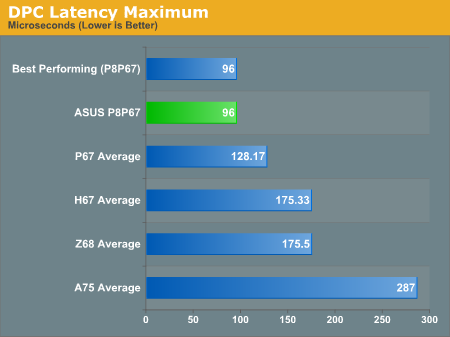
96us is the lowest latency we have had on the Sandy Bridge platform.
USB Speed
For this benchmark, we run CrystalDiskMark to determine the ideal sequential read and write speeds for the USB port using our 64GB Patriot SuperSpeed USB 3.0 drive. Then we transfer a set size of files from the SSD to the USB drive, and monitor the time taken to transfer. The files transferred are a 1.52 GB set of 2867 files across 320 folders – 95% of these files are small typical website files, and the rest (90% of the size) are the videos used in the Sorenson Squeeze test.
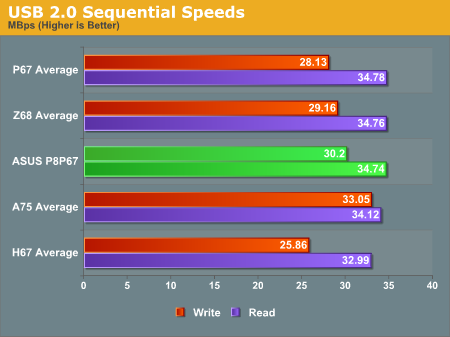
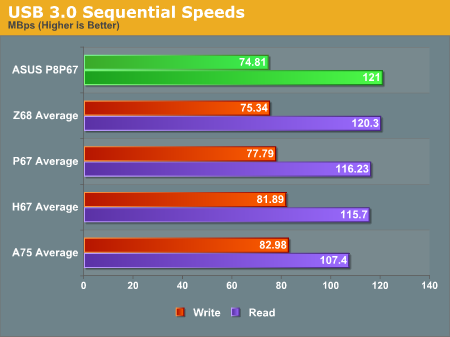

Overall, the P8P67 is only a fraction behind its bigger brother, the P8P67 Pro.
SATA Testing
We also use CrystalDiskMark for SATA port testing. The operating system is installed on the Micron RealSSD C300, which is rated at 355 MBps read and 215 MBps write, and the sequential test is run at the 5 x 1000 MB level. This test probes the efficiency of the data delivery system between the chipset and the drive, or in the case of additional SATA ports provided by a third party controller, the efficiency between the controller, the chipset and the drive.
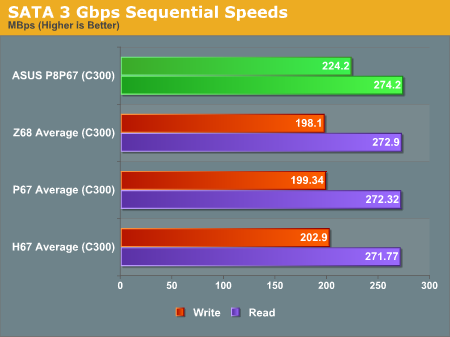

The P8P67 has given us the fastest set of SATA 3 Gbps write speeds we have seen thus far. Strangely enough, it is 25.2 MBps faster than the P8P67 Pro which costs more – however, the P8P67 Pro beats it in read speeds but only by 8 MBps.
Moving on to the SATA 6 Gbps results, the write speeds are good. Second from top is nothing to be sniffed at when you consider the price of the motherboard. The read speeds do not impress as much but they are not the slowest we have seen. It does beat the ASRock Extreme4 and the Gigabyte P67A-UD4 which are both in a similar price bracket but the Gigabyte board does have the upper hand when it comes to read speeds.










52 Comments
View All Comments
DanNeely - Thursday, September 8, 2011 - link
How are raid 5/10 supposed to work on the two gray SATA6GB ports? You need 3/4 drives to implement those levels.IanCutress - Thursday, September 8, 2011 - link
The ASUS website suggests you can build an array across all the PCH SATA3/6 ports, just not the controller ones.Ian
JonnyDough - Thursday, September 8, 2011 - link
Well that seems silly if your array only runs at SATA II speeds...LtGoonRush - Thursday, September 8, 2011 - link
How many people are going to be building RAID arrays out of more than two SATA600 SSDs? No HDD can even approach SATA300 speeds so it's not really an issue .etamin - Friday, September 9, 2011 - link
HDD burst speeds (reads) can surpass 3gbps. I just saw an article showing the Hitachi DeskStar 3TB 7K3000 can burst to about 5gbps...and just because you don't use more than two drives in a RAID array doesn't mean other people don't.WillR - Saturday, September 10, 2011 - link
He didn't say other people don't. He implied only few do. This is a $150 board, not an enthusiast model. Anyone willing to shell out a couple grand on their SSDs alone should look elsewhere for a board, or more likely an add-on PCI-e x8 card with REAL RAID support, to better suit their needs.DanNeely - Thursday, September 8, 2011 - link
Ok, that would make sense. The review could be clearer on the point though.Taft12 - Thursday, September 8, 2011 - link
mdadmDanNeely - Thursday, September 8, 2011 - link
Soft-raid is completely chipset irrelevant.hurrakan - Thursday, September 8, 2011 - link
Thanks for the review.But I wish it was a review of the P8P67 Pro... specifically the new 3.1 revision with USB 3 controllers by Asmedia (instead of NEC).
I prefer single-card graphics anyway - my GTX580 is enough for now :) Consoles have been holding back PC gaming for too long - PC games aren't very demanding on hardware these days :(